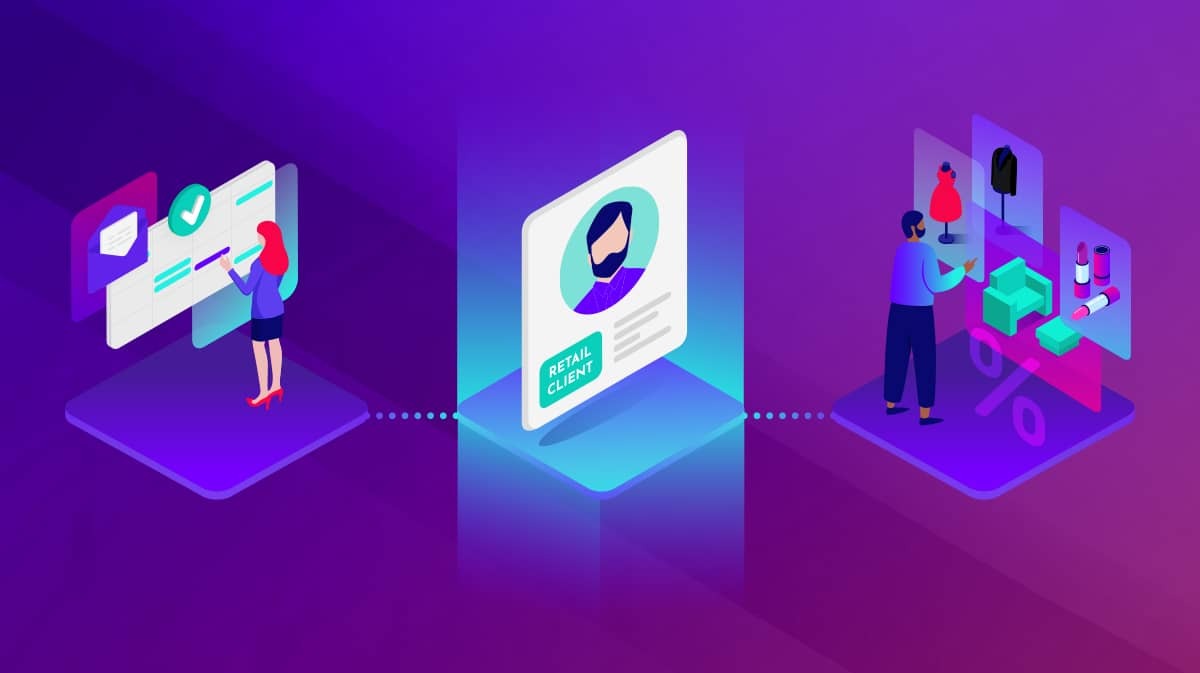Since the beginning of the coronavirus lockdowns, the retail industry has had to innovate to maintain profitability. As restrictions ease, retailers face a new challenge-safely reopening. To help meet this challenge, retailers are reevaluating how to drive an increase in foot traffic as stores begin to open.
In this article, we cover the importance of managing retail foot traffic, tracking foot traffic, directing customer traffic throughout the store, and balancing efficiency and customer service.
Why is it important to manage foot traffic in retail?
As stores reopen, retailers are putting systems in place to protect both employees and customers. Managing foot traffic plays a huge role in catering to consumer comfort levels and safety concerns, meeting state mandates, and understanding staff needs.
What happens when you don’t manage foot traffic
Retailers currently face the difficulty of balancing safety and providing an excellent customer experience. Without a clear plan to manage an increase in foot traffic, retail stores may face a variety of challenges including:
- The spread of illness
- Long lines
- Less employee resource efficiency
- Fewer personalized interactions
- Compromised customer experience
- Data deficiency
In contrast, with a plan to manage an increase in foot traffic, stores can exceed customer expectations, while protecting public safety.
How to manage an increase in foot traffic
During lockdown, many retailers have pivoted to curbside pickup as one method of managing foot traffic. Even before COVID-19, many stores, such as Target, already offered this service. This trend grew by a remarkable 208 percent during the pandemic. On top of that, as one report notes 59 percent of surveyed consumers stated they plan to continue this practice even after the coronavirus pandemic. The appeal of curbside pickup is the ability to shop in the safety of your home, yet receive your purchases quickly and with minimal, if any, contact.
For customers who still desire an in-store experience, retailers have options. First of all, retailers can limit the number of individuals in stores a one time. However, without careful planning, this can create long lines snaking outside of stores and around buildings-not an ideal customer experience.
Alternatively, retailers can pivot to appointment scheduling for in-store visits. By scheduling appointments in advance, customers can avoid physical lines, expect a safe in-store experience, and receive more personalized time with store staff. This also allows staff to block off time to properly disinfect any high-touch areas between customer visits.
Retailers also have the option of creating virtual queues. This provides customers with a stress-free waiting experience. Customers can secure for their place in line via a store kiosk or their smartphone.
The virtual queuing system notifies the customer when it is time to check in without requiring a physical line.
Why customer retention is an important foot traffic retail metric
Acquiring a new customer is much more expensive than retaining an existing one. Before investing in new local inventory ads, or other customer acquisition efforts, retailers should prioritize satisfying and retaining their current customer base.
Our research indicates that customers who prefer shopping in-store do so because they want employees to answer their questions in a way that makes sense to them. Of our survey respondents, 64 percent stated they typically spend more after a face-to-face meeting with a staff member.
In other words, retailers need to listen to customer desires for face time with employees and find ways to (safely) encourage customers to return to their stores. However, without tracking footfall data, retailers will never know if they meet their goals.
The pitfalls of not having a foot traffic management plan
Neglecting to track and manage foot traffic may lead to an incomplete understanding of business efforts. Without data readily available, you may miss key strategic business opportunities. As an example, if you open the store at specific hours for customers with existing health issues, and the store fills up, understanding the pattern will help you better staff for that influx of traffic.
In contrast, tracking store traffic helps retailers keep tabs on the following:
- Peak customer activity times
- Seasonal trends
- Products sold
- Customer time spent in store
- Lost sales
A retailer's failure to recognize traffic patterns can cause understaffing during peak hours. This can lead to frustrated customers and stressed employees. For retailers with multiple locations, traffic pattern numbers provide critical insight to achieve individual store success.
By tracking data patterns and outliers, you can start to investigate the reasons for success or failure. Use this information to continue to move the needle and improve business.
How do retailers track and manage foot traffic?
While more retailers understand the value of foot traffic, not all have invested in the tools to track it. However, as we suggest above, understanding store traffic will help you discover how to optimize your store.
Tracking foot traffic and daily sales
To understand physical store performance, retailers should keep track of foot traffic and daily sales as well as the relationship between the two. Specifically, retailers should analyze the conversion rate of foot traffic to sales, looking at how the number of people entering a location translates into product purchases. If the conversion rate proves unsatisfactory, retail professionals should take steps to investigate the cause of the issue.
One method of investigation requires tracking the customer journey throughout a store. This process can highlight friction points in a store layout. Do customers get confused on where to find products? Did a store employee offer to help them at any point?
To answer these questions effectively—without requiring staff to follow customers throughout a store—stores should invest in automated foot traffic management tools.
Tools for measuring foot traffic in retail locations
Today’s retailers have a wide selection of technology-based foot traffic tools. Each of these helps retailers gain a better understanding of customer interactions.
Virtual queuing technology, for example, can help retailers manage store capacity to help enforce social distancing. This technology works by giving each customer, via smartphone, a number and time frame to visit the store.
Customers can wait for their slot from the comfort of an air-conditioned car or run other errands-knowing they won't give up their place in line. This allows retailers to maintain a safe maximum occupancy and foster an enjoyable customer experience.
As retail returns to normal, technologies such as footfall management can help stores track and analyze foot traffic data. With footfall management, stores benefit from the ability to:
- Set maximum occupancy.
- Know exactly how many people are on-site.
- Eliminate outside lines.
- Guarantee zero wait time.
The best type of tracking system will always depend on the number of locations and size of your stores. Make sure you do your due diligence when comparing prices and viability.
Tips for directing the customer in a retail store
Amid shifting store and shopping trends, customers still rely on a store’s layout and signage. This is particularly important as stores are directing traffic, and limiting capacity in the wake of the pandemic. Keeping this in mind, retailers should evaluate how they strategically guide the customer journey.
How to direct customers to stay longer in your retail stores
Good customer service and customer outreach efforts are key to creating a positive customer experience and retaining loyal in-store shoppers.
As part of their advertising campaigns, many retailers promote in-store events such as DIY workshops, books signings, and workout classes. Lululemon stores, for example, provide free yoga classes—giving potential customers more opportunity to interact with their merchandise.
Retailers can also encourage in-store shopping with the promise of early access to products. According to our research, 64 percent of consumers are more likely to visit a store to receive early access to a product.
Additionally, a retail store can provide conveniences to give consumers an excuse to stay longer in stores. For years, IKEA’s Småland has provided free childcare, so parents can shop without distraction. Other retailers set up charging stations for mobile devices to encourage customers to spend more time in their stores.
However, without an optimal store layout, these perks only go so far to entice customers.
Optimize your store layout to direct customers within your retail store
In one form or another, we are all trained to interact with stores in consistent ways. Interestingly, 90 percent of customers turn right when entering a store. Because of this, retailers need to make sure they have optimized their store layouts to maximize the customer journey. Depending on their niche, retailers typically choose one of four layouts.
Grocery stores and pharmacies typically use a grid layout. This maximizes product displays, minimizes dead space, and encourages predictable traffic flow. However, grid layouts do not provide the unique, experiential retail space many consumers desire.
The herringbone layout is very similar to the grid layout. Retailers typically use this layout in small spaces with little real estate or flexibility.
The loop—or racetrack—layout provides a very experiential approach to the customer experience. Consider IKEA’s one-way path with arrows on the floor to direct store traffic. Loop layouts allow retailers to control the customer journey to the smallest detail. However, this may frustrate customers with a get-in-and-get-out mentality.
Lastly, we have the “free-flow” layout—where rules don’t matter and anything goes! Well, not exactly. Even if they choose not to follow any set rules, retailers should still take data into consideration when designing a creative layout. Make sure you take into consideration common human behaviors, such as turning right upon entering a store, to prevent customer confusion and encourage staff interactions.
Effectively use signage to direct retail customers
Traditionally, signage engages customers by highlighting sales and new products. However, during COVID-19, signs can also help direct customers to maintain social distancing and prevent bottlenecks in aisles.
To maximize health and safety, retailers can add floor stickers at checkouts to encourage a six-foot distance between shoppers. Stores can also install clear signage at the front of their stores to instruct shoppers to wear masks.
How to increase efficiency without sacrificing customer service quality in retail
Customer satisfaction and the business bottom line always go hand in hand. A survey by Gladly showed that 26 percent of customers would switch companies after just one bad experience. After three bad experiences, that number skyrockets to 92 percent. Today’s retail businesses simply cannot afford the cost of delivering a poor customer experience.
Determining customer service expectations in your retail stores
Current technology allows retailers to connect with customers in a myriad of new ways. Instead of talking to a customer service rep from a call center, customers use social media and live chat to ask questions and communicate expectations. To that point, 75 percent of marketers state that social media represents a large portion of their customer service strategy.
While connecting with customers through social media, retailers should focus in particular on online reviews. These reviews provide one of the most direct methods to understand the customer experience. Retailers should look for trends, common phrases, and outliers among reviews. Local business owners especially should pay attention to their reviews and respond promptly - both by responding to the reviewer, and by taking their feedback into consideration.
Inexpensive, effective methods for increasing retail store efficiency
Retailers can work to increase retail store efficiency while satisfying customers and ensuring customer loyalty. Key to doing so is identifying pitfalls in the customer experience—such as waiting in long lines, which we discussed earlier—and solving them.
To help further improve the customer experience, retailers should train employees to regularly interact with customers and provide opportunities for them to do so. At Trader Joe’s, for example, employees restock shelves during business hours to increase the likelihood of customer interaction. In doing so, employees have a valuable opportunity to serve the customer and further impact brand loyalty.
The future of foot traffic
During this time, retailers should make sure they take appropriate steps to protect both employees and customers while maximizing profit. By tracking and managing foot traffic, retailers can better prepare for the future.




